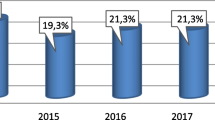Abstract
Background
Lower limb lymphedema (LLL) is one of the most frequent postoperative complications of retroperitoneal lymphadenectomy for gynecologic cancer. LLL often impairs quality of life, activities of daily living, sleep, and sex in patients with gynecologic cancer. We conducted this study to evaluate the incidence and risk factors for LLL after gynecologic cancer surgery in patients who received assessment and periodic complex decongestive physiotherapy (CDP).
Methods
We retrospectively reviewed 126 cases of gynecologic cancer that underwent surgery involving retroperitoneal lymphadenectomy at Tottori University Hospital between 2009 and 2012. All patients received physical examinations to detect LLL and underwent CDP by nurse specialists within several months after surgery. The International Society of Lymphology staging of lymphedema severity was used as the diagnostic criteria.
Results
Of 126 patients, 57 (45.2 %) had LLL, comprising 45 and 12 patients with stage 1 and stage 2 LLL, respectively. No patient had stage 3 LLL. LLL was present in 37 (29.4 %) patients at the initial physical examination. Multivariate analysis revealed that adjuvant concurrent chemoradiotherapy and age ≥55 years were independent risk factors for ≥stage 2 LLL.
Conclusions
To minimize the incidence of ≥stage 2 LLL, gynecologic oncologists should be vigilant for this condition in patients who are ≥55 years and in those who undergo adjuvant chemoradiotherapy. Patients should be advised to have a physical assessment for LLL and to receive education about CDP immediately after surgery involving retroperitoneal lymphadenectomy for gynecologic cancer.

Similar content being viewed by others
References
Abu-Rustum NR, Alektiar K, Iasonos A et al (2006) The incidence of symptomatic lower-extremity lymhedema following treatment of uterine corpus malignancies: a 12-year experience at Memorial Sloan-Kettering Cancer Center. Gynecol Oncol 103(2):714–718
Beesley V, Janda M, Eakin E et al (2007) Lymphedema after gynecological cancer treatment: prevalence, correlates, and supportive care needs. Cancer 109(12):2607–2614
Consensus Document of the International Society of Lymphology (2009) The diagnosis and treatment of peripheral lymphedema. Lymphology 42(2):51–60
Dunberger G, Lindquist H, Waldenstrom AC et al (2013) Lower limb lymphedema in gynecological cancer survivors-effect on daily life functioning. Support Care Cancer 21(11):3063–3070
Kim JH, Choi JH, Ki EY et al (2012) Incidence and risk factors of lower-extremity lymphedema after radical surgery with or without adjuvant radiotherapy in patients with FIGO stage I to stage IIA cervical cancer. Int J Gynecol Cancer 22(4):686–691
Oremus M, Dayes I, Walker K et al (2012) Systematic review: conservative treatments for secondary lymphedema. BMC Cancer. doi:10.1186/1471-2407-12-6
Liao SF, Li SH, Huang HY (2012) The efficacy of complex decongestive physiotherapy (CDP) and predictive factors of response to CDP in lower limb lymphedema (LLL) after pelvic cancer treatment. Gynecol Oncol 125:712–715
Kim YB, Hwang JH, Kim TW et al (2012) Would complex decongestive therapy reveal long term effect and lymphoscintigraphy predict the outcome of lower-limb lymphedema related to gynecologic cancer treatment. Gynecol Oncol 127:638–642
Kim SJ, Park YD (2008) Effects of complex decongestive physiotherapy on the oedema and the quality of life of lower unilateral lymphedema following treatment for gynecological cancer. Eur J Cancer Care 17(5):463–468
Todo Y, Yamamoto R, Minobe S et al (2010) Risk factors for postoperative lower-extremity lymphedema in endometrial cancer survivors who had treatment including lymphadenectomy. Gynecol Oncol 119:60–64
Hareyama H, Ito K, Hada K et al (2012) Reduction/prevention of lower extremity lymphedema after pelvic and para-aortic lymphadenectomy for patients with gynecologic malignancies. Ann Surg Oncol 19:268–273
Ohba Y, Todo Y, Kobayashi N et al (2011) Risk factors for lower-limb lymphedema after surgery for cervical cancer. Int J Clin Oncol 16:238–243
Tanaka T, Ohki N, Kojima A et al (2007) Radiotherapy negates the effect of retroperitoneal nonclosure for prevention of lymphedema of the legs following pelvic lymphadenectomy for gynecological malignancies: an analysis from a questionnaire survey. Int J Gynecol Cancer 17(2):460–464
Achouri A, Huchon C, Bats AS et al (2013) Complication of lymphadenectomy for gynecologic cancer. Eur J Surg Oncol 39:81–86
Graf N, Rufibach K, Schmidt AM et al (2013) Frequency and risk factors of lower limb lymphedema following lymphadenectomy in patients with gynecological malignancies. Eur J Gynaecol Oncol 34(1):23–27
Halaska MJ, Novackova M, Mala I et al (2010) A prospective study of postoperative lymphedema after surgery for cervical cancer. Int J Gynecol Cancer 20(5):900–904
Konno Y, Todo Y, Minobe S et al (2011) A retrospective analysis of postoperative complications with or without para-aortic lymphadenectomy in endometrial cancer. Int J Gynecol Cancer 21(2):385–390
Nielsen I, Gordon S, Selby A (2008) Breast cancer-related lymphodedema risk reduction advice: a challenge for health professionals. Cancer Treat Rev 34:621–628
Kwan ML, Darbinian J, Rademacker AW (1996) Early-stage breast cancer: arm edema after wide excision and breast irradiation. Radiology 198:279–283
Conflict of interest
The authors declare that they have no conflict of interest.
Author information
Authors and Affiliations
Corresponding author
About this article
Cite this article
Deura, I., Shimada, M., Hirashita, K. et al. Incidence and risk factors for lower limb lymphedema after gynecologic cancer surgery with initiation of periodic complex decongestive physiotherapy. Int J Clin Oncol 20, 556–560 (2015). https://doi.org/10.1007/s10147-014-0724-0
Received:
Accepted:
Published:
Issue Date:
DOI: https://doi.org/10.1007/s10147-014-0724-0




